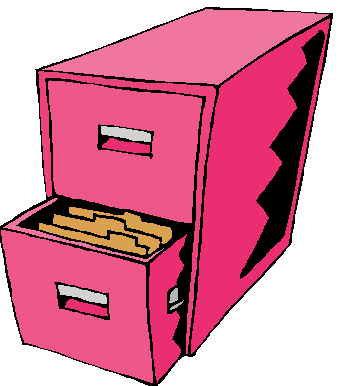Files and Libraries
By Wayne Maruna
If I asked you to
define ‘computer file’, what would you say? Perhaps you’d say it’s a song or a
picture or a typed letter.
Well, yes, those are examples of computer files, but they are not definitions. A web search for the term results in relatively poor results. About the best I could come up with is a mash-up of several definitions:
“A computer file is a bundle of data that composes an entity of saved work that is available to system users as well as to the system itself and its application programs.”
While that may be technically sound, it’s hardly illuminating.
Any idea how many files are resident on your computer? Go ahead, stop reading and take a guess.
I can’t speak for your machine, but the little net book I’m writing this article on, and which I only use for travel, contains over 76,000 files! My main desktop computer at home holds over 373,000 files (yikes)! Your machine’s file count may well also number into the tens if not hundreds of thousands. The key to handling this vast array of files is organization. While the folks working for Microsoft haven’t looked into our closets or pantries or kitchen cupboards or desk drawers or under our beds - at least I hope they haven't - they know we could use help with the concept of organization. They’ve been trying for years to help us organize our files, though their approach has changed over time.
 Prior to the
advent of Windows 95, in the old DOS and Windows 3.1 days, files were organized
into Directories, and those directories were segmented into
Sub-Directories. Some people 'got it', but many didn’t, so Microsoft tried
another
Prior to the
advent of Windows 95, in the old DOS and Windows 3.1 days, files were organized
into Directories, and those directories were segmented into
Sub-Directories. Some people 'got it', but many didn’t, so Microsoft tried
another approach, moving to a
file cabinet analogy. Your hard drive no longer contained directories;
instead it contained folders, like the hanging green PendaFlex folders in
a file cabinet drawer. And instead of sub-directories, they spoke of more
folders, nested into other folders, like the manila folders stuffed into the
green hanging folders. (Systematically nothing changed, just the terminology.)
The file system allowed you to create as many folders as you’d like, but
Microsoft gave you a head start by creating a (hanging green) folder called
My Documents where all your ‘stuff’ would be saved by default if you did not
alter the system to save it elsewhere. If you opened up My Documents, you’d
find additional (think manila) folders nested there with titles like My
Pictures, My Music, or My Videos. The intent was to make it easier for you to
find files you’d saved on your machine in a previous session. Looking for a
photo? Logic would suggest looking first in the My Pictures folder. Of course,
that only works if you or the software you were using played along with
Microsoft’s suggested rules.
approach, moving to a
file cabinet analogy. Your hard drive no longer contained directories;
instead it contained folders, like the hanging green PendaFlex folders in
a file cabinet drawer. And instead of sub-directories, they spoke of more
folders, nested into other folders, like the manila folders stuffed into the
green hanging folders. (Systematically nothing changed, just the terminology.)
The file system allowed you to create as many folders as you’d like, but
Microsoft gave you a head start by creating a (hanging green) folder called
My Documents where all your ‘stuff’ would be saved by default if you did not
alter the system to save it elsewhere. If you opened up My Documents, you’d
find additional (think manila) folders nested there with titles like My
Pictures, My Music, or My Videos. The intent was to make it easier for you to
find files you’d saved on your machine in a previous session. Looking for a
photo? Logic would suggest looking first in the My Pictures folder. Of course,
that only works if you or the software you were using played along with
Microsoft’s suggested rules.
Microsoft’s approach continued through Windows XP and was essentially the same under Windows Vista, though Vista dropped the ‘My’ in front of the personal folder names. ‘My Documents’ became simply ‘Documents’, and the same held for Pictures, Music, and Videos. When you double-clicked the Computer icon in Vista, the display differed from what you saw in XP. The left side of the screen showed shortcuts to get to your Documents, Music, Pictures, and Video folders. Documents was now a separate folder containing user-produced files, and Music, Pictures, and Videos were now folders on an equal footing, not nested into the Documents folder. With the release of Windows 7, things changed again. When a Win7 user clicks on the Computer icon, they see a ‘Favorites’ section, and in the next area below that they see something new called Libraries. So what are libraries?
For starters, Libraries do not contain files or folders. Instead, libraries contain links to folders. To make things more confusing, the default libraries that come in Win7 are named Documents, Music, Pictures, and Videos. And in each of these libraries is a pointer to the actual folders named - stop me if you've heard this before - Documents, Music, Pictures, and Videos. I can hear the AFLACK duck saying “Huh?!”

Because not all software (or every user) conforms to Microsoft’s default approach, libraries are sort of a way to reconcile Microsoft’s approach with that of others. For example, you may choose to keep some of your pictures in folders other than ‘My Pictures’, or you may have music files somewhere other than in ‘My Music’. With libraries, you can add the additional picture folder into the Pictures library, and you can add the additional music folder into the Music Library. In essence, you have a way of aggregating all folders containing pictures into your Pictures library, and all folders containing music into your Music library. No files actually get moved or copied anywhere; they still reside in their original folders. But by having all like music files, for example, referenced in a single library, you can use options to sort and view by artist, genre, album, or song, regardless of the actual folders the music files reside in.
Having been around computers since before the dawn of personal computing, I have to say that I find libraries confusing and superfluous, and I’ve read enough blog posts to know that I am far from alone in my opinion. But I know a lot of people think they’re pretty slick. So if you have a Windows 7 computer, do delve into your ‘libraries’, do some right-clicking and experimenting, and see if you think they are a blessing, a curse, or simply much ado about nothing.